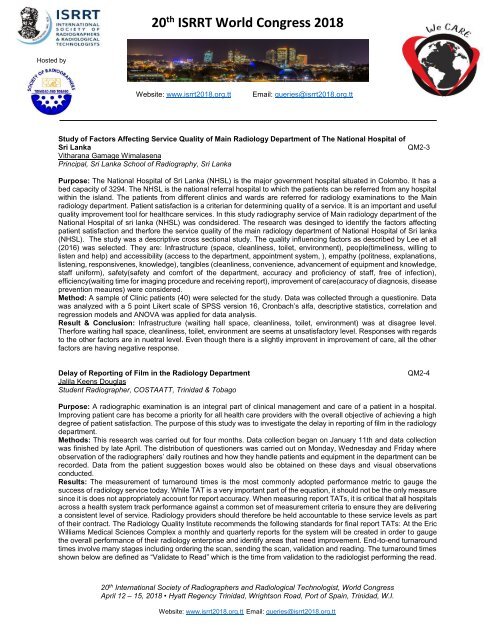Trinidad-and-Tabago-Congerss-Abstract-Book
You also want an ePaper? Increase the reach of your titles
YUMPU automatically turns print PDFs into web optimized ePapers that Google loves.
20 th ISRRT World Congress 2018<br />
Hosted by<br />
Website: www.isrrt2018.org.tt<br />
Email: queries@isrrt2018.org.tt<br />
Study of Factors Affecting Service Quality of Main Radiology Department of The National Hospital of<br />
Sri Lanka<br />
QM2-3<br />
Vitharana Gamage Wimalasena<br />
Principal, Sri Lanka School of Radiography, Sri Lanka<br />
Purpose: The National Hospital of Sri Lanka (NHSL) is the major government hospital situated in Colombo. It has a<br />
bed capacity of 3294. The NHSL is the national referral hospital to which the patients can be referred from any hospital<br />
within the isl<strong>and</strong>. The patients from different clinics <strong>and</strong> wards are referred for radiology examinations to the Main<br />
radiology department. Patient satisfaction is a criterian for determining quality of a service. It is an important <strong>and</strong> useful<br />
quality improvement tool for healthcare services. In this study radiography service of Main radiology department of the<br />
National Hospital of sri lanka (NHSL) was condsidered. The research was desinged to identify the factors affecting<br />
patient satisfaction <strong>and</strong> therfore the service quality of the main radiology department of National Hospital of Sri lanka<br />
(NHSL). The study was a descriptive cross sectional study. The quality influencing factors as described by Lee et all<br />
(2016) was selected. They are: Infrastructure (space, cleanliness, toilet, environment), people(timeliness, willing to<br />
listen <strong>and</strong> help) <strong>and</strong> accessibility (access to the department, appointment system, ), empathy (politness, explanations,<br />
listening, responsivenes, knowledge), tangibles (cleanliness, convenience, advancement of equipment <strong>and</strong> knowledge,<br />
staff uniform), safety(safety <strong>and</strong> comfort of the department, accuracy <strong>and</strong> proficiency of staff, free of infection),<br />
efficiency(waiting time for imaging procedure <strong>and</strong> receiving report), improvement of care(accuracy of diagnosis, disease<br />
prevention meaures) were considered.<br />
Method: A sample of Clinic patients (40) were selected for the study. Data was collected through a questionire. Data<br />
was analyzed with a 5 point Likert scale of SPSS version 16, Cronbach’s alfa, descriptive statistics, correlation <strong>and</strong><br />
regression models <strong>and</strong> ANOVA was applied for data analysis.<br />
Result & Conclusion: Infrastructure (waiting hall space, cleanliness, toilet, environment) was at disagree level.<br />
Therfore waiting hall space, cleanliness, toilet, environment are seems at unsatisfactory level. Responses with regards<br />
to the other factors are in nuetral level. Even though there is a slightly improvent in improvement of care, all the other<br />
factors are having negative response.<br />
Delay of Reporting of Film in the Radiology Department<br />
Jalila Keens Douglas<br />
Student Radiographer, COSTAATT, <strong>Trinidad</strong> & Tobago<br />
QM2-4<br />
Purpose: A radiographic examination is an integral part of clinical management <strong>and</strong> care of a patient in a hospital.<br />
Improving patient care has become a priority for all health care providers with the overall objective of achieving a high<br />
degree of patient satisfaction. The purpose of this study was to investigate the delay in reporting of film in the radiology<br />
department.<br />
Methods: This research was carried out for four months. Data collection began on January 11th <strong>and</strong> data collection<br />
was finished by late April. The distribution of questioners was carried out on Monday, Wednesday <strong>and</strong> Friday where<br />
observation of the radiographers’ daily routines <strong>and</strong> how they h<strong>and</strong>le patients <strong>and</strong> equipment in the department can be<br />
recorded. Data from the patient suggestion boxes would also be obtained on these days <strong>and</strong> visual observations<br />
conducted.<br />
Results: The measurement of turnaround times is the most commonly adopted performance metric to gauge the<br />
success of radiology service today. While TAT is a very important part of the equation, it should not be the only measure<br />
since it is does not appropriately account for report accuracy. When measuring report TATs, it is critical that all hospitals<br />
across a health system track performance against a common set of measurement criteria to ensure they are delivering<br />
a consistent level of service. Radiology providers should therefore be held accountable to these service levels as part<br />
of their contract. The Radiology Quality Institute recommends the following st<strong>and</strong>ards for final report TATs: At the Eric<br />
Williams Medical Sciences Complex a monthly <strong>and</strong> quarterly reports for the system will be created in order to gauge<br />
the overall performance of their radiology enterprise <strong>and</strong> identify areas that need improvement. End-to-end turnaround<br />
times involve many stages including ordering the scan, sending the scan, validation <strong>and</strong> reading. The turnaround times<br />
shown below are defined as “Validate to Read” which is the time from validation to the radiologist performing the read.<br />
20 th International Society of Radiographers <strong>and</strong> Radiological Technologist, World Congress<br />
April 12 – 15, 2018 • Hyatt Regency <strong>Trinidad</strong>, Wrightson Road, Port of Spain, <strong>Trinidad</strong>, W.I.<br />
Website: www.isrrt2018.org.tt Email: queries@isrrt2018.org.tt


















